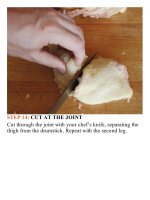The food lab better home cooking through science ( PDFDrive ) 432
Bạn đang xem bản rút gọn của tài liệu. Xem và tải ngay bản đầy đủ của tài liệu tại đây (177.14 KB, 2 trang )
breasts. Rule Numero Uno for great chicken is to start by
buying skin-on, bone-in chicken. Leaving the skin on the
chickennotonlypreventsthebreastmeatfromovercooking
atthesurface,italsoallowsyoutoletthechickencookfora
longer time on one side without the danger of uneven
cookingyou’dgetwithsteaksorchops.Itsbecausechicken
skin,withitsabundanceoffat,isanaturalinsulator.Think
aboutit:fat,throughmillionsofyearsofevolution,hasbeen
designedtohelpregulatetemperature.Itspurposeistoeven
outabruptchangesintemperaturesothatanimalscanmove
relativelyfreelybetweencoldandhotenvironmentswithout
dying of shock. Perhaps it was never intended to see a
situation as extreme as the refrigerator to the skillet, but it
performsitsroleadmirablynevertheless.
With a layer of skin on one side and an insulating bone
on the other, it becomes exponentially easier to cook
chicken evenly. All you’ve got to do is cook it skin side
down first, in a hot skillet (don’t try and move it until it
releases itself freely), then flip it over and toss it into a
moderately hot oven to finish. So long as you’re careful
about monitoring its temperature and allow it to rest, never
againwillyouhavetodealwithanythingotherthanmoist,
juicy, tender meat.And, just like with pork chops, brining
your chicken before cooking can help it to become even
juicier, though it’s a largely unnecessary step, provided
you’re careful with your thermometer, and it has the same
drawback as when brining pork—the chicken flavor gets
diluted with water. I see it more as a safeguard against
overcooking.
BRININGMEAT:THEBIG
TRADE-OFF
C
old, hard fact time: all meat dries out and
toughens as it cooks, particularly in the very hot
zonesonitsexterior.Yetwewantthecentertocook
through. How does one heat the center without
cooking the exterior to dry oblivion? Enter brining,
theprocessinwhichaleancutofmeat(liketurkey,
chicken breast, or pork) is soaked in a saltwater
solution to help it retain moisture during cooking.
Sure, sure—this is nothing new. The Scandinavians
and Chinese have been extolling the virtues of
briningformillennia,butisitworthit?Whatarethe
trade-offs? Before we jump on the bandwagon,
consider a few simple queries: namely, what does it
do,howdoesitwork,andshouldIbother?
WhyBrine?
Let’sstartwithwhatbriningactuallyaccomplishes.
Time to break out the science. I started with a
dozen nearly identical chicken breasts. Three of
them were cooked as is. Three were soaked
overnightina6-percentsolutionofsaltwater(about
½ cup DiamondCrystal kosher salt, or ¼ cup table
salt,perquartofwater)beforecooking.Threewere









